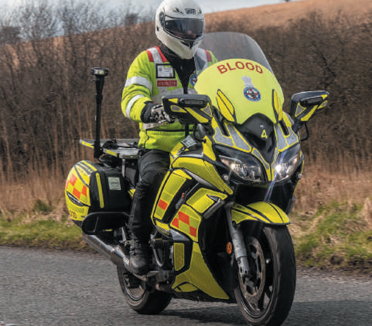Project: To deliver blood for the NHS
Andrew Birkett, programme systems engineering manager at Clayton Systems Consultancy, volunteers for Bristol Blood Bikes, which delivers blood and other life-saving products by motorbike. Here’s how he applies his project management skills…
Chances are that the blood biker is a little‑known entity to most. Unless you have ever needed urgent life‑saving support from the NHS, your only form of contact with this group – collectively known as ‘clots’ – has probably been a fear‑inducing blur of fluorescent livery that appears in your mirrors and progresses to overtake you (safely and legally of course). The last thing on most people’s minds is “there goes one cog in a larger NHS integrated logistic support operating model”.
As a voluntary emergency service, blood bikers are but one link in a critical logistic chain that gets blood from donor to patient. Be it to a critical care paramedic who arrived by helicopter and is administering blood products on the roadside or to a surgeon performing a planned operation. It’s not just blood product either, it’s breast milk to and from Neo‑Natal Care Units, Covid‑19 samples, blood samples, controlled medication and surgical tools.
It’s about now that I can hear die‑hard project practitioners reading this and crying out, “What’s this got to do with project management? This sounds like operations or business as usual – project management is about change and capability not logistics and operations. Blasphemy!” They would, of course, be correct, but perhaps the opportunity is to reflect on how comparable the skill sets of operations and project management are.
Regardless, one thing I hope is agreed universally is the effort to ban project management buzzword bingo across domains. On that note, let’s ‘break it down’, ‘unpack this’ and start our ‘journey’ of comparison with the Bristol Blood Bikers (FreeWheelers EVS).
Team communication is king
A normal night sees many reactive calls from various NHS ‘customers’, all of whom have a differing urgency, location, complexity and cargo type. A night also sees proactively planned blood replenishments with Air Ambulances. A central coordinator receives calls and, using available riders across four sizeable patches (North, East, South and West), plans jobs for riders based on priority, availability, perceived ‘critical paths’, ‘T‑Shirt sized’ timings and resulting rider utilisation.
Perhaps the most important factor are the riders, who, being at the coalface, have route knowledge. Riders offer up alternative routes, options and waypoints often previously unknown to coordinators. This team consultation and feedback is critical to the success of the night. While the coordinator’s blueprint for the night can be reset, the acceptance of the team’s knowledge and ideas across four patches is critical, not only for saving time, fuel or rider fatigue, but also, more importantly, in gaining total team buy‑in and a great shift. Ignore it at a coordinator’s peril!
The people person in the sky
Well‑intentioned plans usually spiral into chaos, with weather, road closures, emergent priority jobs, blood availability, mechanical failures and getting lost adding to a growing backlog. With this chaos and pressure comes fatigue. Solo riding on dark, wet, cold roads for hours at a time puts due diligence and rider safety as a central factor in the coordinator’s mind. It is too easy to simply let things march on with the ‘we are where we are’ mantra.
Much like a project professional, the overseeing coordinator is charged with looking after the team and helping them in ‘sticky moments’, often as the only help around when it goes wrong. It’s more than tracking little motorbike symbols around a map. The coordinator is the team leader, keeping everyone together, motivated and safe. Maintaining contact, promoting good spirits and touching base puts people skills at the heart of their role in understanding a rider’s state of mind. Changing a rider’s plans for their own benefit is a judgement skill of a leader, calling on ‘agile’ to ‘veer and haul’ with other riders, pulling them across patches to cover or even using off‑rota riders to help out for the benefit of a fatigued and less‑aware rider.
Decision‑making under pressure
Riders are often unintentionally first on scene, being nimble and cutting through traffic. Much like project professionals, they call on experience, judgement and personal safety considerations.
One memorable moment for me was when I was avoiding sudden‑braking traffic on the motorway and filtered through the cars to find the cause, which was a two‑lane accident. There were dazed and confused people wandering around live lanes talking and arguing, with children present. Being the liveried‑up bike with blue lights available for use, there is an expectation of being ‘the person in charge’ from the public (albeit without any actual authority), and it falls on a rider’s morality to act (or not).
As such, managing ‘stakeholders’ (road users) to help make a motorway safe and move people to safety is a call on a rider’s decision‑making. In the resulting minutes, watching people in shock behaving in different ways calls on leadership skills in sorting out ambulances, maintaining safety, calming tensions, supporting children in shock and supporting police when they arrive. At which point, emotions are put in a box and a bow tied around it as the rider continues on with the urgent blood product in the bike – remember that is the reason for being on the motorway!
The ‘so what?’
These skills are evidenced in operations but born from project management. They are skills practitioners have in varying degrees, but should be proud of whether in projects, programmes or operations. Not everybody can do project management, and the skills above are testament to project professionals’ natural tendency to be good at them. Noting how similar and transferable the skills are across operations and change projects, shouldn’t handover between them go more smoothly more often?

0 comments
Log in to post a comment, or create an account if you don't have one already.